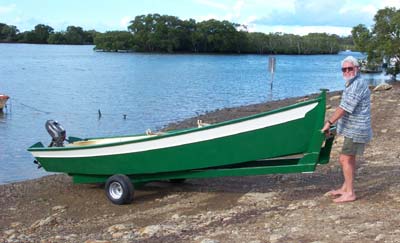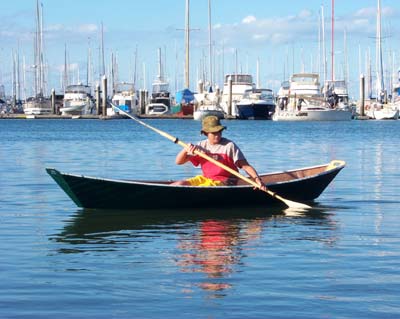Modest Knowledge
Writing letters and emails seemed to take up much of Mike Rowe’s
time, but he tried to answer his correspondence carefully. Throughout
his life he had benefited from other people’s writing,
and owed much to teachers he had never met. Within the limitations
of his experience, he tried to pass on his modest knowledge.
“Dear Bill,
Thanks for your recent letter. It is good to hear that the
project is progressing, and that you are starting to think about
finishing systems, rigging, and powering options. I understand
the excitement.
I have often tried to point out to people that the drudgery
of scraping, sanding, marking and planing are all necessary
evils. How else are you going to be able to stand back and enjoy
the satisfaction of looking at a boat of which you are proud?
It probably sounds corny, but the more you put into the boat,
the more she gives back.
Whatever you do, don’t fall into the trap of using shortcuts
during the painting. There are all sorts of options when choosing
a paint system, and many work very well. However, the ones that
last have a common ingredient, and that is attention to detail.
I have yet to discover a short-cut or miracle system which is
capable of competing with a conventional specification.
As with so many things in life, an evolutionary method is better
than a revolutionary method. The traditional systems have become
traditional because they work!
You have already discovered that the choice of a particular
system may well close doors to other systems permanently. Choose
with care, and with one eye always on the time in the future
when re-finishing comes due. Also consider the requirement for
repairs to minor damage.
The systems which I use have varied with time, and with the
availability of new materials. However, there is a consistent
pattern to a successful paint job, regardless of the type: -
-
Surface preparation
-
Surface sealing
-
Priming/undercoating
-
Topcoating
Skipping any of these steps will degrade the job, and use of
cheap materials will de-value the boat much more than the initial
saving in cost.
My favourite method for plywood or cold-molded construction
is as follows: -
-
Epoxy sealing with any of the good-quality
saturating epoxies;
-
Four coats of high-build epoxy primer/undercoat
applied by brush (high quality brushes are essential for all
work except glueing). I normally sand back heavily after the
second coat, and then do a light sand after the third and
fourth coat;
-
Two, or three coats of high-quality topcoat.
Depending on the nature of the job I use either a two-pack
polyurethane (Hempel Polybest or Boatcraft Pacific Aquacote
water-reducible polyurethane), or a top-grade single-pack
alkyd enamel. Sometimes I spray (particularly with the Aquacote),
but brush application is fine. Unless you have access to a
supplied-air respirator, I recommend that you do not spray
the solvent-based polyurethanes – once again, use a
really good brush. Spraying single pack alkyd enamels is no
problem, but use a filtered mask.

Yes, I know that this is turning into a lecture, but I can’t
help it – sorry! On to something different –
We had a good sail on the weekend in our sixteen foot dinghy.
I know that you don’t like our un-stayed rig, but for
what we have time for it is very good indeed. Our current standing
lugsail was made by a man who understands traditional rigs,
and it works incredibly well. Our elapsed time from driving
into the car park to launching the boat fully rigged is seven
minutes!
Barney’s rig is fast when hard on the wind, but it cost
a fortune in stainless fittings and blocks, takes ages to rig
and strike, and is vulnerable to the failure of any one of many
fittings. If a part breaks, the rig comes down. His rig takes
ages to set and strike - if we raced him out to the island and
back, we would be on the way back in before he had left the
harbour.
The sprit-boom has worked out really well. As an experiment,
we set our sail with a conventional boom using a gooseneck,
and the next time out used the same boom rigged as a sprit-boom.
Without any question the sprit-boom is superior – it is
self-vanging, doesn’t hit anybody’s head, and the
snotter tension is easily altered to suit the conditions and
point-of-sail. The effect is like changing gear in a car.
Being able to repair minor rig damage, independent of chandleries,
is a real advantage. About the only breakage that would affect
us seriously would be loss of the mast – anything else
could be fixed with chewing gum and brown paper. You know, our
rig doesn’t have one inch of wire, uses no bottle screws,
no shackles, no vangs, no gooseneck, no sail track, no winches,
no fairleads, no swaged terminals, no stays and only one pulley
block! And yet we tack through ninety degrees with boat- speed
and regularly plane downwind and on a reach.
Your John Welsford Navigator
is going to be a great boat. The proportions are just about
perfect for daysailing and camp-cruising, and the standing-lug
yawl rig option will exhibit most of the above virtues. In fact,
the rig will be better than mine due to the balance options
the tiny mizzen offers – this will be of particular value
when you reef the mainsail. Not only will rig balance be retained,
but the mizzen will hold the boat up into the wind while you
tie in the reef in the first place. In a squall, you could drop
the mainsail in an instant (due to it being a lugsail) and continue
sailing under jib and mizzen. Sail balance would be fine.
Ian’s Redmond Bluegill is just about ready for him to
pick up. The spars from the un-stayed rig are short enough to
stow inside the boat, and her proportions make her very suitable
for rowing. When you consider that she can also take a ten horsepower
outboard, the design is superb. Very simple to build, no strongback
required, and good looking!

Doug’s Squark design has proved to be a great success.
She may only be eight feet long, but she paddles and tracks
very nicely using a normal kayak double-paddle. Interest in
her has been strong, because people like the idea of a pretty
little open boat that can be carried in one hand and put in
the back of a station wagon, hatch-back or ute.
Anyway, there is work to be done, so I’ll sign off.
Mike Rowe “

|

